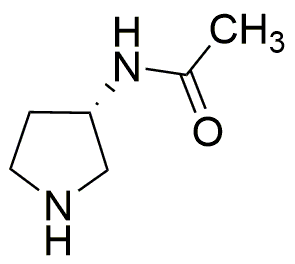|
(3S)-(-)-3-Acetamidopyrrolidine is widely utilized in research focused on
- Pharmaceutical Development: This compound serves as an important intermediate in the synthesis of various pharmaceuticals, particularly in the development of analgesics and anti-inflammatory drugs, enhancing their efficacy and safety profiles.
- Chemical Synthesis: It is employed in organic synthesis as a chiral building block, allowing chemists to create more complex molecules with specific stereochemistry, which is crucial for drug activity.
- Neuroscience Research: The compound is used in studies related to neurotransmitter systems, helping researchers understand the mechanisms of action for certain neurological disorders and paving the way for new treatment options.
- Biochemical Assays: It is utilized in various biochemical assays to evaluate enzyme activity and inhibition, providing insights into metabolic pathways and potential drug interactions.
- Material Science: This chemical finds applications in the development of novel materials, such as polymers and coatings, which can exhibit enhanced properties due to its unique structure.
General Information
Properties
Safety and Regulations
Applications
(3S)-(-)-3-Acetamidopyrrolidine is widely utilized in research focused on
- Pharmaceutical Development: This compound serves as an important intermediate in the synthesis of various pharmaceuticals, particularly in the development of analgesics and anti-inflammatory drugs, enhancing their efficacy and safety profiles.
- Chemical Synthesis: It is employed in organic synthesis as a chiral building block, allowing chemists to create more complex molecules with specific stereochemistry, which is crucial for drug activity.
- Neuroscience Research: The compound is used in studies related to neurotransmitter systems, helping researchers understand the mechanisms of action for certain neurological disorders and paving the way for new treatment options.
- Biochemical Assays: It is utilized in various biochemical assays to evaluate enzyme activity and inhibition, providing insights into metabolic pathways and potential drug interactions.
- Material Science: This chemical finds applications in the development of novel materials, such as polymers and coatings, which can exhibit enhanced properties due to its unique structure.
Documents
Safety Data Sheets (SDS)
The SDS provides comprehensive safety information on handling, storage, and disposal of the product.
Product Specification (PS)
The PS provides a comprehensive breakdown of the product’s properties, including chemical composition, physical state, purity, and storage requirements. It also details acceptable quality ranges and the product's intended applications.
Certificates of Analysis (COA)
Search for Certificates of Analysis (COA) by entering the products Lot Number. Lot and Batch Numbers can be found on a product’s label following the words ‘Lot’ or ‘Batch’.
Numéro de catalogue
Numéro de lot/série
Certificates Of Origin (COO)
This COO confirms the country where the product was manufactured, and also details the materials and components used in it and whether it is derived from natural, synthetic, or other specific sources. This certificate may be required for customs, trade, and regulatory compliance.
Numéro de catalogue
Numéro de lot/série
Safety Data Sheets (SDS)
The SDS provides comprehensive safety information on handling, storage, and disposal of the product.
DownloadProduct Specification (PS)
The PS provides a comprehensive breakdown of the product’s properties, including chemical composition, physical state, purity, and storage requirements. It also details acceptable quality ranges and the product's intended applications.
DownloadCertificates of Analysis (COA)
Search for Certificates of Analysis (COA) by entering the products Lot Number. Lot and Batch Numbers can be found on a product’s label following the words ‘Lot’ or ‘Batch’.
Numéro de catalogue
Numéro de lot/série
Certificates Of Origin (COO)
This COO confirms the country where the product was manufactured, and also details the materials and components used in it and whether it is derived from natural, synthetic, or other specific sources. This certificate may be required for customs, trade, and regulatory compliance.


